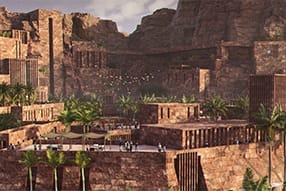Cutting Up The Mountains
Saudi Arabia's latest tourism extravaganza is a luxury resort carved into the ragged rock of the pre-Islamic Nabataean site of Mada'in Saleh
Saudi Arabia is spending around $15 billion on the tourist town of AlUla with its Nabataean ruins, including a resort for the super-rich chiseled into the rocks and mountains that has raised questions about the ruination of ancient patrimony.
Named after a village in the area, AlUla is the trademarked name of the Saudi development project on the site known as Mada’in Saleh in northwest Saudi Arabia that was part of the pre-Islamic Nabataean kingdom. Mada’in Saleh features tombs, homes and palaces carved into rugged mountains similar to the more well-known city of Petra in Jordan, which was the capital of Nabataea.
The resort, called Sharaan, will include 38 suites “carved into sandstone mountains”, according to publicity statements issued by the Royal Commission for AlUla, which is overseeing the work. The resorts and other sites come under the management of AlUla Development — one of the dozens of massive tourism and infrastructure projects owned by the Public Investment Fund (PIF) and which as a whole have been valued at over $1.25 trillion.
The Royal Commission says it will be respecting the ways of the ancients, using “construction techniques that take the ancient Nabataean practice of creating spaces within rock, and then apply modern engineering methods”. Typical for PIF’s giga-projects, the pitch is couched in the language of environmental sustainability. Another resort within AlUla called Azulik, slated to open as early as 2027, will use only electric vehicles; indeed, Azulik will “protect and incorporate nearby ancient rock art inscriptions”. Yet, the official artists impression and video for a research center in AlUla to be called the Kingdoms Institute shows that it will be constructed out of the mountainsides, and in an odd architectural style that mixes pseudo-Nabataean with the kind of futurism seen in the world of gamers and e-sports.
No costs have been made available to the public but real estate consultancy Knight Frank estimates $4.7 billion of AlUla’s total $15 billion price tag will go to these resorts, including $1.1 billion for Sharaan — designed by French architect Jean Nouvel and built by French construction firm Bouygues. The public statements talk of 5,000 hotel rooms by 2030 and 8,500 by 2035 in total.
Sharaan also comes with an aura of ecological authenticity. It will be situated in an area that has been set aside as a nature reserve where US-based animal conservation group Panthera has been working with the Royal Commission on reintroducing the endangered Arabian leopard, as well as gazelles and ibex. But the aim ultimately is to monetize the monuments, mountains and animals. AlUla’s stunning mountain and desert locations are already being used for Hollywood cinema and Arabic TV dramas via Film AlUla. AlUla also stages twice-yearly dance festivals and high-profile outdoor art installations. And there’s an airport that now has international connections such as Paris and London, which has helped raise visitor numbers from 146,000 in 2021 to around 250,000 in 2023.
Saudi Arabia has the ambition of tourism forming 10 percent of GDP by 2030 and the amounts of money pumped into making that happen have been mammoth. A new national air carrier, Riyadh Air, starts operations next year, and it will have a new international airport as its base in Riyadh from 2030. Already existing national airline Saudia is focusing heavily on pilgrim tourism via Jeddah, local airports are being privatized, and licenses given out to more and more budget airlines. A new hajj pilgrimage terminal is being built in Malaysia with Saudi money.
Dissident voices are rarely heard during the frenetic development drive Saudi Arabia is currently witnessing. But despite the assurances of respecting ancient sites, some Saudi commentators, antiquities experts and historians are worried. “AlUla is one of the taboos now,” one said on condition of anonymity. “They give the impression they are clean regarding the environment and keeping the mountain outlines intact, but we don’t know what’s behind the image until we get there — how much has been erased or demolished, or cut down.”




